What is a day like at Big Cat Rescue?
Big Cat Rescue as a Reality TV Show
If we have asked you to come to this page, it’s probably because you have asked about filming a reality TV show here. It makes sense, because people pitch us all the time and the public is always asking why we don’t have our own show. Especially in light of the fact that our founder and CEO was nearly murdered by the kind of people who breed cubs for handling. See Murder for Hire. Some of our supporters have told us they donate monthly, what used to be their cable subscription, because we are so much more interesting and entertaining in our Facebook LIVE and YouTube videos. See our Reality portfolio here.
That begs the next question, which is; “If we have been pitched so many times, why haven’t the networks picked us up?”
I don’t know, but my guess is that it is because we aren’t willing to fake being mean to each other here for the purpose of creating drama (Heaven knows there is enough daily drama here with cat issues as it is) and because we are considered “controversial.” Big Cat Rescue is the leading sanctuary in the world, when it comes not only to big cat care, but also in ending the trade in big cats as pets, props and parts, that causes a need for sanctuaries to mop up the mess. That means the bad guys hate us because we are putting an end to their profitable business of speed breeding big cats, ripping the cubs away for pay to play sessions, and then discarding them into backyards, basements and the black market. They post a lot of lies about us online and I think the networks are afraid of being aligned with an organization who is making a difference.
That’s OK. We probably reach more people with our live Facebook videos, live explore.org/bigcatrescue webcams and YouTube videos anyway. Our views and reach are in the millions weekly across these channels and we get to show you everything that really happens behind the scenes here. I’m not sure a highly scripted and edited television show would reach as many people. We’d love to get that a try, if we are assured that the footage will get the real message out there, which is: Big cats don’t belong in cages. Period.
So, here is a page about why you won’t be able to film us busting down doors and seizing big cats from the bad guys: https://bigcatrescue.org/how-to-rescue-a-big-cat/
and read on below to see what really does happen at a world class sanctuary for captive and wild, exotic cats.
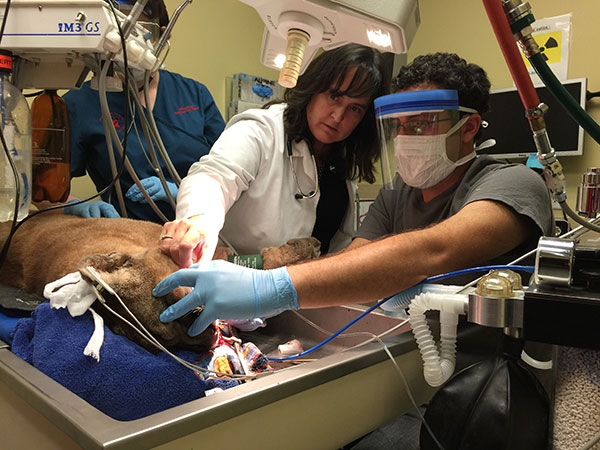
What is a day like at Big Cat Rescue?
Some things happen EVERY day, some things happen a few times a week, some things happen once a month and some things happen once a year. The problem with all of this structured order is that EVERY day there is some chaos introduced, so it is always a balancing act to take care of both the critically important, and the things that have to get done every day.
To Set the Stage
There are about 50 exotic cats on 67 acres and about 80-100 volunteers and staff to care for them. Some cats have more than one cage, or Cat-a-Tat, as we call them, so there are 110 cages and most are the size of a person’s home, up to half acre – 2.5 acres in size.
Every Day
Most of our cats are already past 15 years old, which is very old for these cats. (In human terms, it’s like being over 100) Right now, 20 of our cats are over the age of 20, which is practically unheard of elsewhere. Because we are dealing with so many old age issues we have a LOT of cats who get medications twice a day, EVERY day. If you have ever tried to pill a cat, you can appreciate the lengths our Keepers have to go through to get a cat to take their meds.
Our cats eat every day. Most zoos fast several days a week, but our cats are old and no one likes to go hungry, so 7 days a week the cats are fed by a cadre of volunteers. The food is taken from the freezers to the cooler a day or two in advance to thaw, and then each day special diets have to be made up for a huge number of our cats, because of medical issues they have, and all of the cats are fed. We feed whole prey rats and rabbits two days a week, which arrive frozen, and the rest of the week it is a combination of a ground beef diet, that has their vitamins and minerals pre mixed in, and chicken and beef chunks.
This is the happiest time of the day for the cats. A couple hours before feeding they all start pacing around and calling out to the Keepers when they hear the wagons hauling the buckets, full of food, coming down the path. Keepers shut the most dangerous cats out of the feeding lockouts before feeding time, so they can safely drop the food in on the platters. Then the cats are let in to feast!
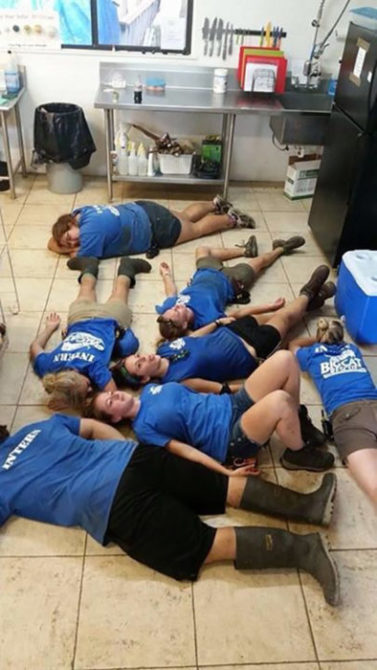
All the buckets and utensils have to be washed, floors in food prep mopped and food set out for the next day to thaw.
Another thing that gets done every single day is the Cat-a-Tats all get cleaned. That’s like cleaning 110 homes a day where the inhabitants poop all over the place and try to hide it.
Each Cat-a-Tat has one to three bowls for water and a platter for food. Every single day the water is dumped out, the bowls are scrubbed and refilled, and the platters are sanitized and washed down.
If the cats dragged their food into the cage, the Keepers have to spot it and pull it out using long, L shaped scraper rakes to get the stuff to the side and tongs to pull it out through the side of the cage.
This is probably why no one comes to our barbecues.
A lot of things are going on while the cats are being fed and cleaned as well. All Keepers are looking for changes in the cats’ condition, behavior, food left behind and what the cats’ scat looks like. They are looking for cage and grounds maintenance issues as well. As soon as they finish feeding and cleaning they log into the computers and record their observations. Those observations immediately generate emails to the vet group for animal health issues, and to the maintenance people for the cage and grounds work. The Operations Manger, the CEO and the President are copied on all of these observations in real time so we all know what is happening.
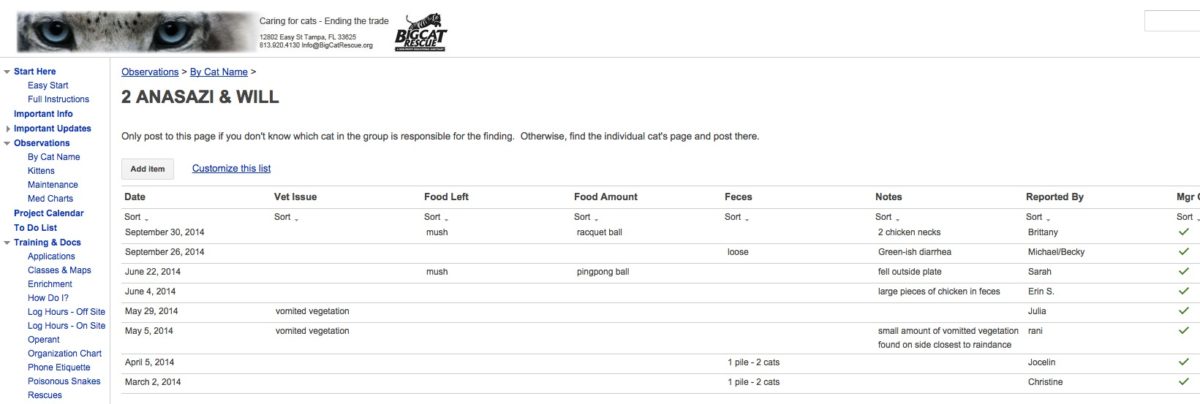
Any of our volunteers or staff can subscribe to these alerts if they want to be informed and they all have access to our BigCat.me Intranet site where these issues are reported. The Operations Manager then has to check off the Observation, once she has taken a look at the issue, so that everyone knows that someone in charge has double checked the situation. All of the health related issues become a permanent part of each cat’s record.
Public Tours
We are closed to the public on Thursdays, but every other day of the week we have guided tours. All tours are led by a tour guide, with a back up to keep everyone together. They are done in groups of 25 or less, so everyone can hear as the guide shares the stories of the cats and what people can do to protect them in the wild and from captivity.
Weekdays

We have a tour every week day at 3 PM (except Wednesdays & Thursdays) We also often will have busloads of children from schools, scouts, summer camps, etc. and busloads of cruise ship guests. We offer private tours throughout the day, as we have volunteers available to give them, so there are often small groups of people learning about the cats and their issues.
Weekends
We have the large guided tours three times each weekend day, as we have many more of our volunteers available on week ends than on week days.
Specialty Tours
We also have Feeding Tours, where guests watch the Keepers feed and learn about what cats eat in the wild and at Big Cat Rescue. We have Keeper Tours where guests learn how to make enrichment for the cats and then go with the Keepers to see it handed out. Once a month we offer a Night Tour. Sometimes we have really special, special tours; like this week a Keeper from Spain, where we are helping a sanctuary build a facility for rescued circus cats, is coming for a week, so she will be shadowing our people in every aspect of what we do. Many of our private tours are for VIPs, large donors, other rescue groups, and those who pay extra for them.
Training the Volunteers
All of our animal care is done by volunteers. We can do that because of the intense training our volunteers get. Every day volunteers are taking classes, from other volunteers, and are getting their certifications. A certification is a sign off they get from a coordinator (the person in charge that day) saying they are proficient at the task. There are always at least 3 sign offs needed for each certification to be complete. So the way training works is:
1. The volunteer takes the class by watching a video or being read to by another volunteer.
2. They take and pass a test.
3. They go out and watch someone do it right 3 times.
4. They go out and do it, while being watched by a coordinator 3 times, to be sure they got it right.
5. They are certified as competent for the task.
6. Later in their career they can apply to be a teacher or coordinator to help train and lead others.
There are 50 or more of these classes they have to progress through, in a particular order for them to be able to proceed up the ranks of Red, to Yellow, to Green to Navy Blue. We use shirt colors to show a person’s level of expertise and time spent with us. Red is first 6 months and requires 4 hours a week, Yellow is next year and a half and requires 6 hours a week, Green is after 2 years and requires 8 hours a week. Keepers have to be Green to feed or clean the lions, tigers, or leopards. Navy is after 4 years and requires 16 hours a week of volunteerism.
Our interns train 6 days a week, daylight to dark, so they fast track through these levels. They live onsite and come from all around the world because this kind of training isn’t available anywhere else. You can take all of the same training provided to our volunteers at ZooCollege.com with the exception of the hands on observation and certifications.
Training the Cats
Every day the Keepers do Operant Conditioning with the cats. This is training the cats to do things we need for administering their vet care, by using positive rewards (meat on a stick) to get them to do things like, show us their paws, open their mouths, let us give shots or draw blood from their tails. We never with hold food and never punish a cat in any way, so it is fun for them.
Cats are so smart that keeping them entertained is one of our toughest jobs. Operant Conditioning is a great way to alleviate their boredom. In addition to training the cats, the Keepers are constantly being trained and certified.
Enrichment
Enrichment is made on Wednesday nights by a dedicated group of volunteers who come to the sanctuary after work. In order to have enough enrichment to hand out every day, it takes them hours to stock the freezers with blood ‘cicles and tuna pops. The volunteers make daily enrichment items that are small, easy to hand out and enough of them for all of the cats to get something new every day.
These creatives also manufacture, from all safe materials, some pretty spectacular mock ups of rhinos, giraffes, mice, Pinatas, Valentine’s day items, etc. Some just for the fun of it and others for filming for our holiday themed videos or for special occasions. Watching the cats tear these toys apart is a lot of fun because the cats show such gusto for it.
The cats get other seasonal enrichment items such as pumpkins for Halloween, turkeys for Thanksgiving, Christmas trees, and watermelons in the summer.
The Stores Support the Cats
The Gift Shop is open every day but Thursday, so there is always a lot going on in there. Our online and gift shop sales generate a lot of money for the cats so Partners (our non Keeper volunteers) are always busy fulfilling orders and shipping them, answering phone calls that range from: “Where are you located?” To “I have a lion I want to get rid of.” Get those calls a lot.
Whenever you’re talking retail, you have a lot of decisions to make as to what will sell, labeling, organizing the shelves and the storage areas, seasonal decorations, and the dreaded annual inventory, which is an event of epic proportions, including a buffet to help everyone get through it.
Partners are trained to be nice to guests, to be able to answer questions or find someone who can, to keep the Gift Shop looking spiffy, to manage the huge groups of people (sometimes a few hundred at a time) who are all piling into our store before their tour. Our store is about 3000 square feet, so it’s crowded in there. We play our videos, via our Roku channel on a T.V. in the tour waiting area, so guests can get a preview of what we do while they are waiting. We are very strict about how people are to behave around the cats so we have a video they watch on our rules right before the tours.
We have had to raise our tour prices every few years because we have become too popular and can’t handle the crowds and still maintain the tranquility of a sanctuary. We use a ticketing agency to handle our tickets and scheduling, which has increased revenues considerably and it tells us an hour in advance how many people are coming. We still have to scramble to find tour guides and back ups, and there is a considerable amount of cross scheduling, to make sure nothing falls through the cracks, when you are dealing with about 35,000 guests each year.
Our tours have 3 different ways of being done. Very small tours will be a guide just talking with the guests as they walk around the property spotting cats. Large tours usually have the guide wearing a transmitter and the guests each wearing a receiver with a headset, so they can hear. What they hear will either be the guide talking or we have an iPhone / Android app called Big Cat Rescue, where guides can play the stories of the cats. We prefer this method as it insures the guest gets an accurate message. Memorizing all of the cat stories has proven difficult for the best of tour guides.
At the end of the tour, people are asked to contact their lawmakers to ask for laws that ban the private possession of big cats, and to end the cub handling that causes all of the surplus big cats to be bred, used and discarded. They are greeted by one of our Legislative Interns who helps them place the call or write the letter on the spot.
People tell us all the time how surprised they were to get a thank you from us. We make it a habit to send a written thank you note to every donation over $25. When you consider our income is over 4 million dollars a year, that’s a LOT of thank you notes.

It seems like there are a steady parade of trucks delivering piles of mail (that has to be sorted out to the right staff), supplies, water, soft drinks and the MEAT TRUCK. When the meat truck arrives it is all hands on deck to quickly transfer thousands and thousands of pounds of cat food into the freezers. We can store about 20,000 pounds of meat in our two freezers and the cats consume about 300 pounds a day.
Managing Volunteers
Big Cat Rescue keeps all of its fundraising and admin costs under 17% (35% is considered the industry goal) by only paying staff to manage people and having all animal care done by volunteers. Because of the way we manage the sanctuary and our finances we have one of the highest charity ratings given at Charity Navigator. Even though we are closed to the public on Thursdays, we still have to manage volunteers 7 days a week.
That includes making sure they know they are appreciated by sending the birthday cards, anniversary (of joining Big Cat Rescue) cards, get well cards, condolence cards and showing our appreciation through recognition on our Intranet site. It means making sure they have clean conditions to work in and an environment where we all adhere to a Code of Conduct that encourages respect.
Taking care of our staff and volunteers means making sure their equipment and software is working, up to date, virus free and a lot of trouble shooting with computers, routers, Vox boxes, Internet connections, the registers, Roku, a stack of iPads and iPhones, that are used for tours and caring for the cats.
Managing Interns

Every day there are intern issues to deal with from screening and interviewing new ones, arranging their flights, visas, airport pickup and trips out for groceries, if they don’t have cars, to training them, to doing house inspections to make sure they are caring for their foster kittens properly and keeping the houses clean.
Interns move on site for 3 months at a time and for many of them it is the first time they have ever been away from home. We give a crash course in how to get along with others (up to four others in their house) and how to take care of themselves, domestic kittens and, of course, all of our big cats.
All volunteers and interns clock in and out on a Volgistics time clock. We have to monitor that everyone is putting in sufficient hours for their color level and we reward those who are over achievers. Every class and certification has to be documented in every volunteer’s file, and when they seek a promotion, all of their coordinators have to be consulted to vote on the promotion.
If there are any conflicts the Volunteer Committee sits down with both parties to hash it out in an environment that ensures privacy and a resolution that works for everyone.
Foster Kittens
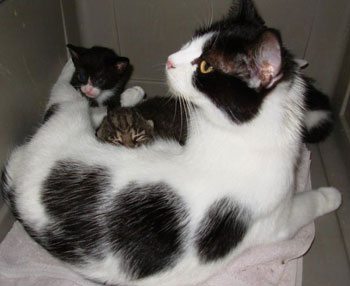
We are a NO TOUCH facility! Anyone caught touching an exotic cat is thrown off the property and never allowed back in. As you can imagine, our people LOVE cats and really, really, really want to touch them so we partnered with the Humane Society of Tampa Bay and Fostering is Cool to help save kittens and their moms from being killed in county run shelters.
We take the moms with kittens, or the orphaned kittens who are too young to adopt, and bottle raise them until they reach 2 pounds. They are then returned to the Humane Society of Tampa Bay to be altered and adopted. Many kittens come to us so young they have to be bottle fed every 4 hours around the clock. The interns keep the kittens in their houses at night, and bring them to the Kitten Cabana during the day, so they can continue their care.
When the kittens are weaned and get their shots, the other volunteers can play with them in the Kitten Cabana. It’s great therapy for our cat loving crew and the kittens are so loving and trusting, after all the handling, that they are adopted right away. We’ve helped save hundreds of cats and kittens since 2013.
We are a news distribution service for anything exotic cat related. We have google alerts set for most species of wild cat and other terms such as zoos, sanctuary, etc. We curate the news daily via Pressly and then broadcast it out to the key word specific pages of our website and to our social sites. We also comment on the most pertinent stories, to educate reporters and readers about the truth of the matter and give links, documents and statistics to back it up. We are changing the conversation out there from, “Oh, how cute it is to pet a tiger cub!” to “Where is that cub’s mother and where will that cub go when it gets too big to pet next month?”
 Disseminating our message; which is that big cats don’t belong in captivity, is done daily via our website which gets upwards of 3.5 million unique visitors a year, on our Facebook page that has more than 2.5 million fans and often has weeks where our reach has extended past 10 million people, our YouTube channel which has had more than 1 million subscribers, and a plethora of other social sites like Twitter, Pinterest, Instagram, Google Plus, Alexa and others. We can’t just post our position and walk away. We have to engage in two way conversations with hundreds of thousands of people in order to help them understand the big picture when it comes to cats in cages.
Disseminating our message; which is that big cats don’t belong in captivity, is done daily via our website which gets upwards of 3.5 million unique visitors a year, on our Facebook page that has more than 2.5 million fans and often has weeks where our reach has extended past 10 million people, our YouTube channel which has had more than 1 million subscribers, and a plethora of other social sites like Twitter, Pinterest, Instagram, Google Plus, Alexa and others. We can’t just post our position and walk away. We have to engage in two way conversations with hundreds of thousands of people in order to help them understand the big picture when it comes to cats in cages.
Managing Real Estate
The founder donated many real estate parcels to the sanctuary over the years to create an income stream for the cats that was not tied to tourism or donations. This means there are daily issues of renting properties, evicting non paying squatters, marketing and selling homes, developing vacant lots and selling them, paying taxes, doing site inspections, dealing with county employees who drag their feet in permitting, trying to find new ways to keep tenants from stealing all of the appliances when they leave in the middle of the night, getting people to pay their mortgages, paying lawyers and grounds keeping on empty parcels.
So Far This Has Been the Daily Grind!
Weekly Tasks
There have been times when we had to perform K-Laser therapy on several of our cats in an experiment to cure hot spots, lameness and arthritis. So far the lameness in a bobcat, caused by a blood clot, has resolved, but we are still working on the others. We hold a blood ‘cicle or tuna pop on a stick through the side of the cage so the cat comes up close enough for the laser.
Some things only happen once a week, like going to the big box store and stocking up on snacks for the volunteers, cutting the grass, and big projects like painting a cage, or landscaping. Thursdays are usually set aside for doing big projects because we don’t have to break at 3 pm to do tours.
The vets are both volunteers and they often come out twice a week. They have a list, from the Observation Charts, and go out to check on cats and make recommendations for their care. They may decide to bring a cat into our onsite hospital, or to their clinic. Last year we had nearly 90 vet procedures which was up from only 20 the year before. As our cats continue to age, we expect those procedures to continue to escalate.
Laying out the medications for the cats is a weekly task for someone on our vet care team. They have to count out all of the pills, delete them from our inventory, put them in bags, labeled for the right cat and the right instructions, and these are kept under lock and key.
About once a week we will be asked to host some sort of corporate, church, school or other team building event where non volunteers come for a day and do something for the cats. Since we can’t let untrained people near the cats, these projects are usually grounds maintenance.
Once or twice a week we field calls from the press about some situation in the news. These are excellent opportunities to reach far beyond our own fan base with our message. We do LIVE Facebook posts for The Dodo Impact and their Spanish channel, El Dodo. They take a lot of time, but it’s worth every minute.
Every week we are contacting and educating lawmakers, influencers and decision makers so they choose animal friendly options. This is done via email, phone calls, in person visits and hand written cards and letters.
Monthly Tasks
About once a month, or every other month we are called on to rescue a cat. If it is a native bobcat that has been hit by a car or injured by a hunter then there is usually a death defying chase involved and it always seems to end up in a lake or river. There is then all of the emergency care for the bobcat and then weeks of rehab.
If the call is about a captive cat then we have to get the owner to contract with us to never own another exotic cat. We won’t let people dump adult cats on us just so they can try out a new baby. If they agree then we have to coordinate with their vet, or a vet in their area to issue a health certificate and we have to get an import permit from the Florida Wildlife Commission. In most cases we have to go get the cat and that could be anywhere in the U.S. The kind of people who have wild animals as pets are usually a crazy lot and dealing with them makes you want to pull your hair out.
They usually talk in manic circles as if they are on crack, they don’t return calls, they keep putting off the vet visit or the rescue, they give you false information, they don’t want you to tell anyone about what they did, they don’t show up the day you arrive to get their “pet” and they are just generally unreliable.
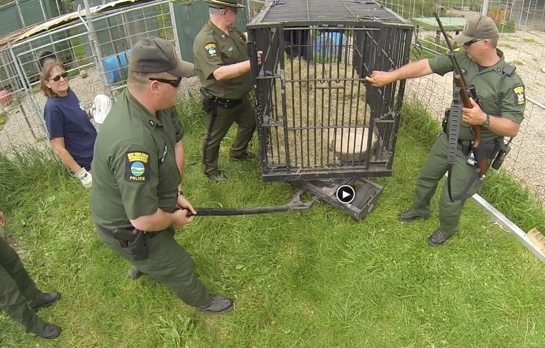
Sometimes it is a governmental seizure, so we can’t tell anyone where we are going or what we are doing until we have the cat safely in the vehicle and are heading back to Tampa. In most cases either the agencies, or the owner won’t allow any filming, so the most exciting work we do, is usually not something we can show. The shortened time for letting supporters know about the rescue is also a choke hold on donations.
The time leading up to and during a rescue is when people are most likely to donate. Once the cat is safely within our gates, most are off to the next exciting rescue and don’t think about the fact that we have just made a lifetime commitment to caring for the cat we just rescued. One tiger will cost us 10,000 a year for every year the cat lives with us. Several of our cats live into their twenties, so in a case like that, if they were rescued at the age of 10, they would typically cost us 150,000 over their lifetime here.
The cats are de-wormed and de-flea’d once a month. It’s no easy task either because they don’t like the taste of the wormer and if you ever tried to put Advantage or Revolution on your own cat, you know they smell that coming a mile off and run under the bed. Same here, but their beds are big concrete cave dens. We have to get more clever all the time.
Golf carts need battery maintenance and washing. A/C filters have to be replaced. Sheds are reorganized. The vehicles may need oil changes, washing, tires checked, etc.
The Holleys are a couple of volunteers who come in a couple times a month to build platforms and “ADA” ramps for our old cats.
We send out a monthly newsletter called the AdvoCat to 90,000+ people on our email list. Each e-zine typically has 10 or more stories including updating our supporters on cats rescued, cats who are ailing, cats who have died, digital holiday goodies for them, exciting news in the cat world, progress on legislation to ban the private possession of big cats, and 3-5 of the most shocking examples of exotic cat exploitation and a call to action for people to speak up for the cats.
Quarterly Tasks
The Big Cat Times is a printed newsletter that we write, publish and distribute quarterly. We try to reach as many people as possible via email, but some of our audience still prefer the printed version. This has the top stories from the AdvoCat newsletters and breaking news, along with a couple of pages of mail order gifts that support the cats.
We host Volunteer Appreciation parties that can range from having a cat expert come and speak to the volunteers, to staff dunk tanks and lawn games at a pot luck lunch, to taking them out to see a big cat presentation at the theater, to costume parties, jewelry making parties, karaoke and anything else we can think of, to show these wonderful people who donate so much of their time, how much we love them.
About once a quarter we will have to put ourselves in the uncomfortable position of being in close proximity to those who abuse big cats for profit and see us as one of the primary threats to their activities. It may be a stake holder meeting by the state’s wildlife department, or a town hall meeting, or a congressional meeting, where we have to go to make sure the only people the decision makers hear from are not just the industry, that profits from using the big cats as pets and props and for their parts. The kind of people who breed tigers, rip the cubs away from their moms and then use them as pay to play money makers are a nasty bunch of people and will try to bully us out of the venue. This has resulted in being physically attacked, vehicles damaged and having insults hurled at us for speaking up for the animals.
Annual Tasks
The cats have to be vaccinated. Operant Conditioning helps a lot, but nobody likes getting stuck with a needle; much less with two. The cats get the same vaccines as your domestic cats (but a killed virus) and a rabies shot. We have some cats who are due for their boosters soon.
We became famous for a black tie event called The Fur Ball and won a number of awards for this gala that attracts up to 800 guests. It took a year of preparation though and we stopped doing the Fur Ball in 2010 to focus more intently on legislation to end the trade in wild cats. Our supporters beg us, all the time, to do it again, so maybe next year. What made the Fur Ball such a hot ticket was that it was all about having fun whereas most fundraisers are all about patting yourself on the back and thanking sponsors.
We attend Taking Action for Animals and have been the largest sponsor of the event for the past 6 conferences. We often present at this event. We attend CatCon with more than 16,000 attendees, Animal Sheltering Expo and other cat related conferences and workshops that are annual events. We host an onsite event called the Wildcat Walkabout Safari Day, or something similar that will attract more than 600 guests. We donate to conservation projects every year around the world. It’s always the first Saturday in November (to also celebrate our Nov 4 founding date).

Annual events include our state and federal inspections. The breeders, dealers and animal exploiters make a career out of filing false complaints, so we have to deal with such inspections a lot more frequently than annual because the bad guys include OSHA, the EPC and many other government agencies on their speed dial list of ways to harass us.
These agencies have been forced to come out here on bogus complaints so many times that they are usually embarrassed to do so, and the complaints never amount to anything.
We have to renew licenses, permits, Combined Federal Campaign applications, solicitation permits in all of the states, and contracts for printing and distribution of our brochures.
Emergencies
Emergencies are pretty frequent, given the age of our cats and the number of things that can go wrong. Some of our cats are prone to seizures, and there isn’t much you can do for a big cat who is having a seizure, but it usually means someone stays with the cat and the vet is called if they don’t recover right away. To us it is an emergency if a cat doesn’t eat for two or three days in a row. Cats hide their illnesses well because in the wild, it is survival of the fittest.
If a cat stops eating then we either hand feed the cat so we know exactly what is going in and what is coming out, or we may have to move them inside the Cat Hospital to monitor that. That is especially true if the cat is weak, unresponsive to their environment, or it is cold or rainy. The vets will be alerted and the first one with an opening in their schedule will see the cat, either on site or at their own clinics. This all sounds pretty easy, but getting a sick cat into a transport cage is no easy matter.
It usually takes 4-6 people and we start the easy way and work our way up to the hard way as methods fail. We always try to get the cat to load themselves. This would be to shut the cat in half of their cage and put a transport in the other side of the cage, covered with a blanket to be a nice dark spot, at the guillotine door. We open the guillotine door and try to surround the side of the cage the cat is in, so they will want to walk away from us into the box. If that doesn’t work, we try to lure them into their feeding lockout, but that’s hard to do if they aren’t eating well to begin with. If we can lock them in that area, then we move the transport box up to that guillotine door and try to shoo the cat over.
If that doesn’t work and the cat is smaller than a cougar, we may have to suit up with boots, gloves and nets and go catch the cat. The cat is then shifted from the net to the transport box. If that isn’t an option, because the cat is a cougar or bigger, or because the cat is too aggressive and dangerous, then we have to resort to darting the cat. That is always a last ditch effort because sedation is very hard on the cats and if they are sick, doubly so. Any time a cat is sedated there are hours of sitting with them to make sure they wake up.
Thankfully, except for medical emergencies, most of the day to day emergencies are relatively minor, like a hose bib busts and there’s water spraying everywhere until we shut down the well pumps. Then there’s no water for cleaning cages, toilets, etc. while we scurry to replace the pipes and fixtures. A cat catches a possum and we have to rescue the “sleeping” critter. The front end loader breaks down and we put it back together with bailing wire and duct tape. A rabid raccoon starts threatening the cats and has to be caught and sent for testing. (that’s happened three times) A tree falls down, or is about to, and we have to become lumber jacks. The road washes out from heavy rains and we have to have tons of rock delivered and then have to spread it over the quarter mile road that leads to our front gate.
Moving Forward
If we are known for anything, it is probably for being influential and innovative in our approach. We are always looking for a better way to do our work. This includes major undertakings, such as building up an endowment to make sure we can always provide for the cats we have rescued. It includes automating our tours, our training, our observations and management of the cats, using ZIMS for our medical records, installing solar panels to provide clean energy and we took Big Cat Rescue completely off the grid by partnering with Arcadia Power to ensure that ALL of our energy comes from wind, solar and other totally earth friendly sources. We built a Vacation Rotation area that is 2.5 acres so that all of our big cats get two 2 week vacations in the area each year and a FunCation for all of our smaller cats to get a 22,000 sf vacation area and are working on another small cat vacation area that is as long as a football field.
We have 9 LIVE webcams throughout the sanctuary that were provided by explore.org. There are nine of these currently and many of them are pan, tilt, zoom 1080p cameras that are driven all day by New Earth staff and volunteers for explore.org You can find these at explore.org/bigcatrescue
It is easy to fall into a rut of responding to one crisis after another and never taking the time to think about the future. Instead we take a strategic approach to make sure the cats we have already rescued will have optimal care until they die of old age. This business like approach enables us to do the things necessary to provide that care. Our donors are kept abreast of everything we do and jump in to help.

In 2014 a couple donated a much needed X-ray machine, which meant we had to build the new Windsong Memorial Hospital to house it. They helped with that and other donors, large and small, began chipping in to buy a surgery table, a dental wet table, autoclave, monitors and just about everything necessary to completely outfit the new hospital. We built the Windsong Memorial Hospital with a viewing theater that has a glass floor, so our volunteers can learn from the medical procedures without being in the room. We were able to take one generous donation of the machine and leverage it into creating a much needed facility that will mean no travel time for our cats to go to outside clinics and a much improved learning center for volunteers who are studying to be vets and vet techs.
We help other sanctuaries and rescue groups do the same by sharing our resources at workshops, conferences and one on one. We built the Big Cat Alliance website, which is a community website for all of our sanctuary partners to use that enables us to speak with one voice and not have to reinvent the wheel. We are always looking for a way to do things better and make the world a better place for cats… and people.
In 2019 we opened the world’s first Augmented Reality Zoo in a Tampa mall and a second location in Plantation, Florida. All of the cats at those locations are augmented reality or virtual reality. Find out more at ARzoo.me



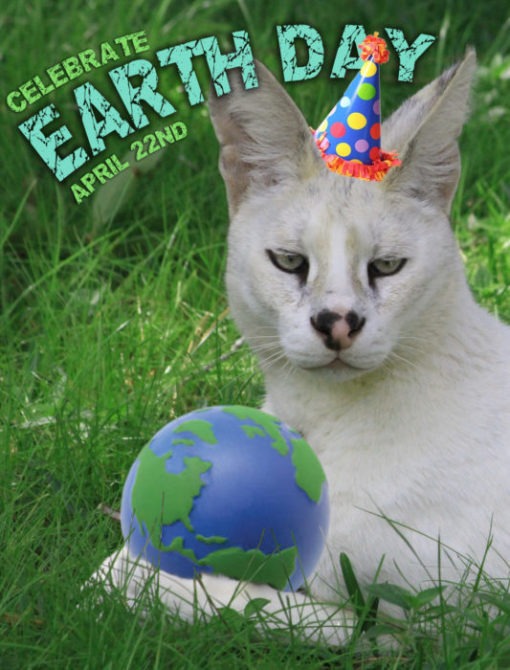

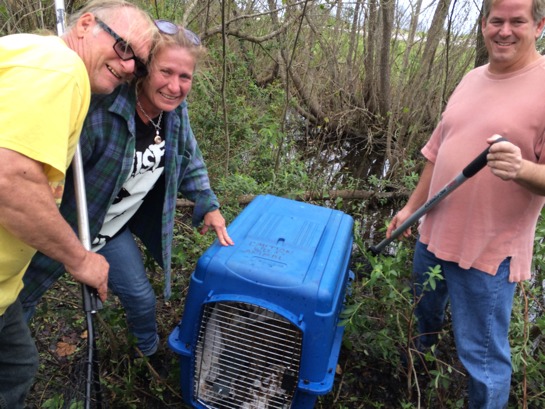
it is amaising